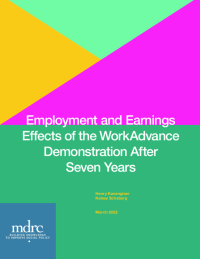Employment and Earnings Effects of the WorkAdvance Demonstration After Seven Years

 This report summarizes the long-term—Year 7—findings of a rigorous random assignment evaluation of WorkAdvance, a sectoral training and advancement initiative launched in 2011. Sectoral strategies such as WorkAdvance train people for quality jobs in specific industries and occupational clusters where there is strong local demand and the opportunity for career advancement. The WorkAdvance model is heavily influenced by the positive findings from the Sectoral Employment Impact Study completed in 2010, as well as earlier research on job-retention and career-advancement strategies.
This report summarizes the long-term—Year 7—findings of a rigorous random assignment evaluation of WorkAdvance, a sectoral training and advancement initiative launched in 2011. Sectoral strategies such as WorkAdvance train people for quality jobs in specific industries and occupational clusters where there is strong local demand and the opportunity for career advancement. The WorkAdvance model is heavily influenced by the positive findings from the Sectoral Employment Impact Study completed in 2010, as well as earlier research on job-retention and career-advancement strategies.
The WorkAdvance model was implemented between June 2011 and June 2013 by four providers—Per Scholas, St. Nicks Alliance, Madison Strategies Group, and Towards Employment—and a total of 2,564 individuals enrolled in the study. Several previous reports described the implementation, participation, benefits and costs, and interim impact findings of WorkAdvance, and showed encouraging evidence for the WorkAdvance model. The impact findings presented in those reports covered up to six to eight years of follow-up.
This report presents the economic impacts of WorkAdvance seven years after individuals entered the study, as measured using federal administrative data (data collected for the administration of a public program or policy). Two outcomes—total annual earnings and the percentage of people with annual earnings of at least $40,000—are considered the main indicators of WorkAdvance’s success in Year 7 (or “confirmatory”).
Main Findings
- The WorkAdvance program at Per Scholas increased average earnings (by 14 percent) in Year 7; there were no statistically significant effects on average earnings at the other three sites.
- The WorkAdvance programs at Per Scholas, St. Nicks Alliance, and Towards Employment increased the proportion of people who earned $40,000 or more in Year 7.
- None of the WorkAdvance sites increased employment by a statistically significant amount in Year 7 (a secondary, or “exploratory” outcome). Coupled with the statistically significant impacts at most sites on the percentages of people earning at least $40,000, this finding suggests that WorkAdvance group members are advancing in their careers over time, as the model intended.
Overall, the WorkAdvance results show that sector programs can increase earnings in the longer term and can lead to career advancement gains over time, but that not all sector programs will lead to increases in employment and earnings. Focusing future efforts on how to make the sectoral approach more consistently successful can help workforce providers strengthen sector-based programs. Another report from the WorkAdvance evaluation will describe the impacts of the model 10 years after study enrollment.






